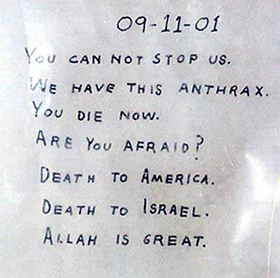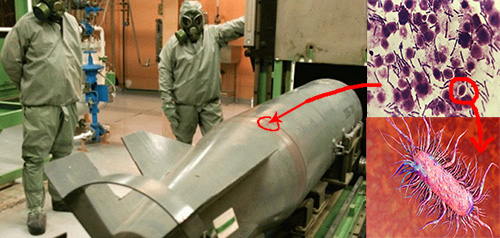In both World Wars they used everything they had. If they had had more, they would’ve used more.
So, I can’t possibly imagine a third World War without nuclear, biological and chemical bombs. The first who starts the war will try to totally annihilate the enemy, by throwing everything he has. This means the next World War will be one dominated by Weapons of Mass Destruction.
No doubt, nuclear weapons have the most destructive power, but not the most killing power.
FEMA gives one indication of the potential killing power of these agents compared to conventional high explosives.
According to FEMA, to produce about the same number of deaths within a square mile, it would take:
- 705,000 pounds of fragmentation cluster bomb material
- Equivalent to 7,000 pounds of mustard gas
- Equivalent to 1,700 pounds of nerve gas (sarine)
- Equivalent to 11 pounds of material in a crude nuclear fission weapon
- Equivalent to 3 ounces of botulin toxin type A
- Equivalent to ½ ounce anthrax spores
Most Common Biological Weapons
Biological Warfare agents are microorganisms like virus, bacteria, fungi, protozoa (or toxins produced by them) that give rise to diseases in man, animals or plants and cause large-scale mortality.
Anthrax

Although rare in the United States, anthrax is still common throughout the developing world.
In 2001, letters containing anthrax spores were mailed to several news media offices and two Democratic U.S. Senators, killing five people. According to the FBI, the ensuing investigation became “one of the largest and most complex in the history of law enforcement”.
Scientists examining the anthrax from the New York Post letter said it appeared as a coarse brown granular material looking like Purina Dog Chow.
“Inhalation anthrax” develops when you breathe in anthrax spores. It’s the most deadly way to contract the disease, and even with treatment it is often fatal. Initial signs and symptoms of “inhalation anthrax” include:
- Flu-like symptoms, such as sore throat, mild fever, fatigue and muscle aches, which may last a few hours or days
- Mild chest discomfort
- Shortness of breath
- Nausea
- Coughing up blood
- Painful swallowing
- High fever
- Trouble breathing
Treatment:
All types of anthrax infection can be treated with antibiotics, including intravenous antibiotics (medicine given through the vein). If someone has symptoms of anthrax, it’s important to get medical care as quickly as possible to have the best chances of a full recovery.
At the same time anthrax toxins in the body cause severe illness. After anthrax toxins have been released in the body, one possible treatment is antitoxin. Antitoxins target anthrax toxins in the body (example – anthrax antitoxin – Valortim)
Bubonic Plague
Some of the earliest instances of biological warfare were said to have been products of the plague, as armies of the 14th century were recorded catapulting diseased corpses over the walls of towns and villages to spread the pestilence.
Later, plague was used during the Second Sino-Japanese War (1940) as a bacteriological weapon by the Imperial Japanese Army (air-dropped plague-contaminated fleas which caused epidemic plague outbreaks).
Without treatment, the bubonic plague kills about two thirds of infected humans within four days.
Some victims with the bubonic form of the disease may develop secondary pneumonic plague (a disease similar to pneumonia). Pneumonic plague is the most severe form of the disease and if untreated, most people die.
Treatment
If treated with antibiotics, buboes typically become smaller in 10-14 days and do not require drainage. Victims are unlikely to survive primary pneumonic plague if antibiotic therapy is not begun within 18 hours of the beginning of symptoms. Without treatment, 60% of people with bubonic plague die, and 100% with pneumonic and septicemic forms die.
Antibiotic treatment includes aminoglycosides such as streptomycin and gentamicin, tetracyclines (especially doxycycline), and ciprofloxacin.
Brucellosis (Malta Fever)
These bacteria were weaponized by several advanced countries by the mid-20th century. In the US – 1954 – at Pine Bluff Arsenal near Pine Bluff, Arkansas. Brucella and all other remaining biological weapons in the U.S. arsenal were destroyed in 1971–72 when the American offensive biological warfare program was discontinued by order of President Richard Nixon.
Treatment
Antibiotics such as tetracyclines, and gentamicin are effective against Brucella bacteria. However, the use of more than one antibiotic is needed for several weeks, because the bacteria incubate within cells.
Botulism
 Botulinum toxins have been developed into biological weapons agents for its extreme potency and lethality (60%). The toxin causes serious paralytic illness that leads to death.
Botulinum toxins have been developed into biological weapons agents for its extreme potency and lethality (60%). The toxin causes serious paralytic illness that leads to death.
It is reported that 3 countries the US labels as ‘state sponsors of terror,’ North Korea, Iran, and Syria, developed botulinum toxins as possible biological weapons agents.
Botulinum toxin, one of the most toxic poisons known, is derived from a bacterium that occurs naturally in forest soils, lake and stream sediments and the intestinal tracts of some fish and animals.
Botulinum toxin gained public attention after a vial of the bacteria was found by investigators in Iraq after the ouster of Saddam Hussein. At the end of the 1991 Gulf War, Iraq claimed it had produced 19,000 liters of the toxin; if true, it was an amount capable of killing the entire population of the earth. (Source)
It is also the most dangerous bacteria that forms in spoiled canned foods. (Read more: How to tell when your canned foods become spoiled)
Treatment
The primary treatment of botulism is with an antitoxin (human botulinum immunoglobulin) and supportive care. The respiratory failure due to paralysis may require a person to be on a ventilator for weeks, plus intensive medical and nursing care. After several weeks, the paralysis slowly improves.
Glanders
The acute form results in coughing, fever, and the release of an infectious nasal discharge, followed by septicaemia and death within days. In the chronic form, nasal and subcutaneous nodules develop, eventually ulcerating. Death can occur within months, while survivors act as carriers.
The U.S. (and Soviet Union) studied this agent as a possible biological weapon but did not weaponize it.
Treatment: Sulfadiazine, Ciprofloxacin, Tetracyclines (3 months on two antibiotics)
Melioidosis (Whitmore Disease)
Symptoms include acute pulmonary infection, localized infection of the skin and fatal septicemia (symptoms are similar to glanders).
Treatment: Similar to Glanders (but for five months)
Variola Virus (Smallpox)
Smallpox infection was eliminated from the world in 1977.
In people exposed to smallpox, the vaccine can lessen the severity of or even prevent illness if given within 4 days after exposure.
The United States currently has an emergency supply of smallpox vaccine.
There is no proven treatment for smallpox but research to evaluate new antiviral agents is ongoing. Patients with smallpox can benefit from supportive therapy (intravenous fluids, medicine to control fever or pain, etc.) and antibiotics for any secondary bacterial infections that occur.
Biological weapons have the most killing power, but they are difficult and expensive to develop. That is why we have rarely seen them used in terrorist attacks.
Why Ebola was not mentioned
Because it is difficult to weaponize! The Ebola virus is relatively fragile. Its lifetime on dry surfaces outside of a host is only a couple of hours, and while some studies have shown that the virus can survive on surfaces for days when still in bodily fluids, this requires ideal conditions that would be difficult to replicate during transport.
You may also like:
 7 Things That You Should Never Do After An EMP
7 Things That You Should Never Do After An EMP
US Nuclear Target Map. Do You Live in The Death Zone? (Video)
Ingenious Foods People Made During Famines
Turning Flour into Hardtack Biscuits With Over 100 Year Shelf Life
Resources:
The US Armed Forces Survival Manual











